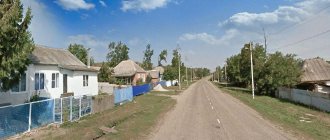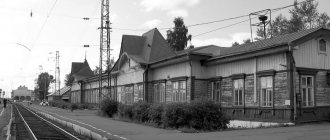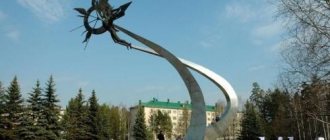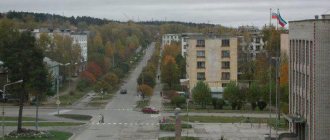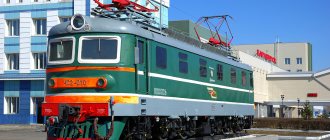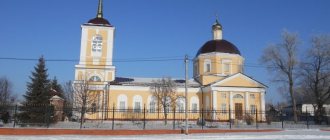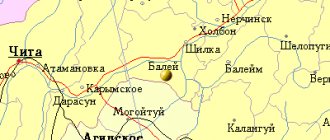| City | |
| Zakamensk | |
| Zakhaamin hoto | |
| 50°23′ N. w. 103°17′ E. d.HGYAO | |
| A country | Russia |
| Subject of the federation | Buryatia |
| Municipal district | Zakamensky |
| urban settlement | City of Zakamensk |
| Head of a city settlement | Tsyrenov Mikhail Sergeevich |
| History and geography | |
| Based | 1934 |
| Former names | until 1944 - Dzhidastroy until 1959 - Gorodok |
| City with | 1944 |
| Square | 59.22 km² |
| Center height | 1100 m |
| Climate type | sharply continental |
| Timezone | UTC+8:00 |
| Population | |
| Population | ↘11,191[1] people (2021) |
| Nationalities | Russians, Buryats and others |
| Confessions | Orthodox, Buddhists |
| Katoykonim | Zakamenets, Zakamenets |
| Official language | Buryat, Russian |
| Digital IDs | |
| Telephone code | +7 30137 |
| Postcode | 671950 |
| OKATO code | 81221501 |
| OKTMO code | 81621101001 |
| Zakamensk Moscow Ulan-Ude Zakamensk | |
| Media files on Wikimedia Commons | |
Zakamensk
(until 1959 -
Gorodok
, Bur. Zakhaamin Khoto) - a city of regional significance in Russia, the administrative center of the Zakamensky district of the Republic of Buryatia and the urban settlement "City of Zakamensk". Since 2015, the city has had the honorary international title “City of Labor Valor and Glory”
Population - 11,191[1] people. (2021).
The municipal formation of the urban settlement of the city of Zakamensk is included in the list of single-industry municipal formations of the Russian Federation (single-industry towns) in the category of municipal formations with a stable socio-economic situation[2].
It is located near the border zone - to visit it you must present a passport of a citizen of the Russian Federation or a permit from the border service.
Content
- 1 History 1.1 Gornyatsky village
- 1.2 Town
- 1.3 In the post-war period
- 1.4 Post-Soviet era
- 2.1 Physiographic location
- 4.1 City Park
- 6.1 Preschool education
- 7.1 Industry
- 8.1 Printing
- 12.1 Topographic maps
Story
The history of the city is closely connected with the history of the discovery and development of tungsten and molybdenum deposits in the Dzhidinsky ore cluster and the production of tungsten and molybdenum concentrate at the Dzhidinsky mining and processing plant.
In 1929, Doctor of Geological and Mineralogical Sciences A.V. Arsenyev made a substantiation of the presence of a primary tungsten deposit in the Zakamensky region of the Buryat-Mongolian Autonomous Soviet Socialist Republic.
On July 9, 1932, a geological exploration party led by M.V. Besova opened the first quartz vein with large wolframite crystals in the Gudzhirka Pad, discovering the Dzhida tungsten deposit.
Gornyatsky village
On March 2, 1933, the working settlement of Gorodok
.[3]
On October 11, 1934, the People's Commissar of Heavy Industry of the USSR Sergo Ordzhonikidze signed an order to open Dzhidastroy, and the construction of the Dzhidinsky tungsten-molybdenum plant began. Initially, the workers' settlement was located on the site of the village of Modonkul, located at the confluence of the Modonkul River with Dzhida.
In 1935, a place was chosen for the founding of the working village of Dzhidastroy - between the village of Modonkul and the Inkur mine, in a vast bird cherry grove. Already in the fall, a road was laid, houses, a dining room, a store and a bathhouse were built. The following year, barracks-type houses for workers were erected. In the same year, a bridge was built across the Dzhida River, heavy machinery and equipment began to be imported, and the Kholtoson mine was launched. Molybdenum mineralization was discovered in the Pervomaisky area. The share of local tungsten accounted for 65% of production throughout the country.
In 1938, the village of Dzhidastroi officially received the status of an urban-type settlement. In 1939, the mining and processing plant and the Kholtoson mine were put into operation. In 1941, a narrow-gauge railway was built and the Pervomaisky molybdenum mine was created. The following year, a molybdenum enrichment plant began operating. The mining and processing plant was finally formed. The Great Patriotic War began, the Tyrnyauz mining and processing plant was occupied, as a result of which the local plant became the main supplier of tungsten in the country.
From February 13, 1941, further construction of the Jidakombinat was transferred to the jurisdiction of the NKVD of the USSR. Dzhidinlag was organized, the workforce began to be replenished at the expense of prisoners[4][5].
Beginning in March 1943, deported Germans, resettled earlier, mostly women, mobilized for forced labor, arrived in Dzhidastroy. They are employed in the extraction and washing of ore concentrate and logging[6].
Town
In 1944, the village of Dzhidastroy received city status and a new name “Town”. A theater and kindergartens appeared, and the service sector developed. In 1949, Dzhidinlag was transformed into LO UITLC of the Ministry of Internal Affairs of the Buryat-Mongolian Autonomous Soviet Socialist Republic. The Jida Combine itself was transferred back to 1945 to the jurisdiction of the People's Commissariat of Non-Ferrous Metallurgy of the USSR. At the same time, a large group of Japanese prisoners of war arrived there[7]. The plant employed a large number of civilian workers, but the number of prisoners involved in the work was still greater. In 1953, Dzhidlag was liquidated, which caused a sharp reduction in the number of workers at the plant. To replenish personnel, it was necessary to recruit specialists in other regions, which took a lot of time.[8]
In the post-war period
In 1959 the city was renamed Zakamensk. During the 1950s, street lighting appeared, comfortable 3-4-story houses were built, a mining technical school and a consumer services plant were opened.
On April 2, 1963, Zakamensk was transformed into a city of republican subordination. The towns of Bayangol, Inkur and Kholtoson are subordinate to the City Council[3].
On January 13, 1965, the city of Zakamensk and the town of Inkur were transferred from republican subordination to the Zakamensky district[3]. The city of Zakamensk became a regional center.
In 1967, a cultural palace with a hall for 600 seats was built and put into operation. In 1973, the Pervomaisky mine was closed due to the complete development of the deposit. In 1974, a new bridge across the Dzhida River and an air terminal building were built. In 1983, the Gornyak cinema with 400 seats appeared. In 1989, the plant was recognized as the winner in the All-Union Socialist Competition and was included on the All-Union Honor Board of the Exhibition of Economic Achievements of the USSR. In 1990, school building No. 5 was built for 1,500 students.
Post-Soviet time
Abandoned workshops of the Victory Memorial Dzhida Combine in 2015 On
October 27, 1992, the plant was transformed into the Dzhida Combine OJSC. Due to the conversion of the military industry, production volume is reduced by 70%.
In 1995, tungsten production decreased by 4 times compared to 1989. The State Reserve Committee sells 13,500 tons of tungsten at dumping prices; next year Kazakhstan will also sell 10,000 tons of tungsten. Prices on the world market have decreased by a third, sales have decreased by 2.2 times, as a result, costs are one and a half times higher than the cost of production. Thus, the government’s rash actions in the absence of state support put the enterprise in a hopeless situation.[9]
On February 26, 1998, the Dzhida tungsten-molybdenum plant ceased to exist[10].
In 2006, Zakamensk LLC began work on the extraction of alluvial tungsten at the Inkursky deposit. Later, having received licenses for the development of tailings dumps, it ordered the development of technology for extracting metal from old sands. In 2008, a plant for processing waste from the Dzhida VMC was put into operation, which extracts tungsten with associated gold and silver[11]. Later, in 2010, she won a competition for the use of subsoil in the area of the Kholtoson and Inkur deposits, planning to build a new mining and processing plant in the coming years[12].
In May 2014, the Tamir universal sports complex was opened[13].
On May 5, 2015, the city of Zakamensk received the title “City of Labor Valor and Glory”[14]. On May 7 of the same year, in a solemn ceremony in Victory Square, the T-62K “General Tank” tank was installed on a pedestal in honor of the veteran home front workers of the Dzhidinsky tungsten-molybdenum plant [15] [16].
Map
| Zakamensk: maps |
Zakamensk: photo from space (Google Maps) Zakamensk: photo from space (Microsoft Virtual Earth)
| Zakamensk Nearest cities. Distances in km. on the map (in brackets along roads) + direction. Using the hyperlink in the distance , you can get the route (information courtesy of the AutoTransInfo website) | |||
| 1 | Baykalsk | 139 (732) | NE |
| 2 | Petropavlovka | 145 () | IN |
| 3 | Slyudyanka | 145 (767) | WITH |
| 4 | Kyryong | 165 (900) | NW |
| 5 | Bolshoy Lug (Irkutsk region) | 197 (864) | WITH |
| 6 | Jida | 206 () | IN |
| 7 | Shelekhov | 209 (846) | WITH |
| 8 | Markova (Irkutsk region) | 213 () | WITH |
| 9 | Molodezhny (Irkutsk region) | 220 () | WITH |
| 10 | Irkutsk | 222 (866) | WITH |
| 11 | Kyakhta | 224 (432) | IN |
| 12 | Meget (Irkutsk region) | 232 () | WITH |
| 13 | Babushkin | 233 (605) | NE |
| 14 | Khomutovo (Irkutsk region) | 243 (890) | WITH |
| 15 | Angarsk | 243 (910) | WITH |
a brief description of
Located in Transbaikalia, on the slopes of the Dzhidinsky ridge, on the right bank of the river. Dzhida (tributary of the Selenga), 245 km west of the railway. Dzhida station, 420 km southwest of Ulan-Ude.
Territory (sq. km): 59
Information about the city of Zakamensk on the Russian Wikipedia website
Historical sketch
July 9, 1932 by a party of geologists M.V. Besova discovered the first quartz vein with tungsten crystals in the Gudzhirka pad. This is how the discovery of the Dzhidzhinsky tungsten deposit took place. The village of Dzhidastroy was founded in 1932. The Jidkombinat became the first-born of the mining industry of Buryatia. In 1934, the first workers—miners—appeared at the plant. By the end of 1934, 123 people worked at the plant.
In 1935, a place was chosen to build a city. It was a bird cherry grove between the river. Inkur and R. Modoncul. Barrack-type houses for workers and employees began to appear in 1936.
Since 1938, the working settlement of Gorodok. In 1944 it was transformed into a city and received the name Gorodok. In 1959 it was renamed Zakamensk. The name of the area Zakamen has been known since the 18th century. and designates the territory lying behind the spurs of the Dzhidinsky ridge and Small Khamar-Daban, i.e. Behind the stone.
Municipal indicators
| Index | 2001 |
| Demography | |
| Number of births, per 1000 population | 9.7 |
| Number of deaths, per 1000 population | 15.6 |
| Natural increase (decrease), per 1000 population | -5.9 |
| Standard of living of the population and social sphere | |
| Average monthly nominal accrued wages, rub. | 1479 |
| Average housing area per inhabitant (at the end of the year), sq.m. | 18.2 |
| Number of preschool institutions, pcs. | 5 |
| Number of children in preschool institutions, thousand people | 0.5 |
| Number of daytime educational institutions (at the beginning of the school year), pcs. | 4 |
| Number of students in daytime educational institutions, thousand people | 2.7 |
| Number of doctors, people. | 47 |
| Number of nursing staff, people. | 229 |
| Number of hospital institutions, pcs. | 1 |
| Number of hospital beds, thousand units | 0.3 |
| Number of medical outpatient clinics, pcs. | 3 |
| Capacity of medical outpatient clinics, visits per shift, thousand units. | 0.8 |
| Number of registered crimes, pcs. | 169 |
| Persons who committed crimes were identified, persons. | 127 |
| Economy, industry | |
| Number of enterprises and organizations (at the end of the year), pcs. | 317 |
| Construction | |
| Volume of work performed by type of activity “Construction” (until 2004 - volume of work performed under construction contracts), million rubles. | 3.5 |
| Commissioning of residential buildings, thousand sq.m. of total area | 0.8 |
| Commissioning of residential buildings, apartments | 15 |
| Commissioning of preschool institutions, places | 0 |
| Commissioning of educational institutions, places | 0 |
| Commissioning of hospital facilities, beds | 0 |
| Commissioning of outpatient clinics, visits per shift | 0 |
| Transport | |
| Number of bus routes (in intracity traffic), pcs. | 2 |
| Number of passengers transported by buses per year (in intracity traffic), million people. | 0.2 |
| Connection | |
| Number of residential telephone sets of the city public telephone network, thousand units. | 1.8 |
| Trade and services to the population | |
| Retail trade turnover (in actual prices), million rubles. | 65.6 |
| Retail trade turnover (in actual prices), per capita, rub. | 4558 |
| Public catering turnover (in actual prices), million rubles. | 1.3 |
| Volume of paid services to the population (in actual prices), million rubles. | 27.8 |
| Volume of paid services to the population (in actual prices), per capita, rub. | 1931 |
| Volume of household services to the population (in actual prices), million rubles. | 0.4 |
| Volume of household services to the population (in actual prices), per capita, rub. | 25.4 |
| Investments | |
| Investments in fixed assets (in actual prices), million rubles. | 14 |
| Share of investments in fixed assets financed from budgetary funds in the total volume of investments, % | 43.1 |
Data sources:
- Regions of Russia. Main characteristics of the constituent entities of the Russian Federation: statistical collection. Goskomstat of Russia. - M:, 2003.
Economy
Dzhida tungsten-molybdenum plant, clothing factory, construction enterprises.
In the Zakamensky district, grains, potatoes, vegetables, etc. are grown. Cattle, pigs, and sheep are raised. Horse breeding.
Deposits of gold, tungsten, molybdenum, coal, jade, marble, etc.
| Population by year (thousands of inhabitants) | |||||||
| 1939 | 10.2 | 1998 | 15.0 | 2008 | 13.3 | 2016 | 11.2 |
| 1959 | 13.8 | 2000 | 14.6 | 2010 | 13.1 | 2017 | 11.2 |
| 1970 | 12.7 | 2001 | 14.5 | 2011 | 11.5 | 2018 | 11.2 |
| 1979 | 13.2 | 2003 | 12.7 | 2012 | 11.5 | 2019 | 11.2 |
| 1989 | 15.6 | 2005 | 13.0 | 2013 | 11.5 | 2020 | 11.2 |
| 1992 | 16.3 | 2006 | 13.1 | 2014 | 11.5 | 2021 | 11.2 |
| 1996 | 15.5 | 2007 | 13.1 | 2015 | 11.4 | ||
Geography
Physiographic location
Zakamensk
View from the mountain. The city is located in the southwest of Buryatia near the state border with Mongolia, 404 km from Ulan-Ude, in the central part of the Dzhidinsky ridge. It is located in the mountain-taiga area of the Modon-Kul River valley, a right tributary of the Dzhida River. The height of the bottom of the mountain valley is about 1100 m above sea level; medium-high mountains with absolute elevations of 1300-1400 m are adjacent to the city.
Ecology
The city is located in the mountain taiga zone, remote from other industrial centers, in the valley of a small watercourse originating in Mongolia. However, the environmental situation in most of the city and its surroundings is extremely unfavorable. Ecologically, the territory of Zakamensk and the former Dzhida tungsten-molybdenum plant is the most disadvantaged part of the Baikal natural territory[17].
Ecological problems
Dust storm before a thunderstorm
The Dzhida plant is a polluter of all components of the natural environment. The ores that were mined by the tungsten-molybdenum plant contain chemical elements belonging to various hazard classes: class I - cadmium, lead, zinc, fluorine; to class II - molybdenum, calcium; to class III - beryllium, tungsten, bismuth, rubidium, cesium; in addition, rocks with high sulfide contents were mined. When enriching tungsten-molybdenum ore by flotation, toxic reagents were used - kerosene, sulfuric acid, xanthate, pine oil, liquid glass, etc., which also accumulated in tailings. In total, during the period of operation of the Dzhida tungsten-molybdenum plant, 44.5 million tons of waste were generated. Partially man-made waste was used to fill roads, city sites, and build houses. In the process of wind spread, transfer and erosion by surface and underground waters, soils, vegetation, air, underground and surface waters became contaminated with toxic compounds [17] [18].
Modonkul River Pebbles in the bed of the Modonkul River, covered with a crust of salts.
The main sources of pollution are technogenic sands from the tailings of waste from the processing factories of the closed Dzhidakombinat, and mine, adit, quarry, and basement waters of the Gudzhirka, Inkur streams and the Zapadnaya adit, containing water-soluble forms of ore elements, and polluting soils in the city through surface and underground runoff and the waters of the Modonkul and Mirgensheno rivers. Mine waters and tailings are characterized by the greatest contamination. In mine waters, the excess of the maximum permissible concentration of some elements (, , , , , , , etc.) from hazard classes I-III near pollution sources reaches tens and hundreds of times [17][19][20], in the tailings the content of heavy metals reaches 100 and more than the maximum permissible concentration, according to the indicators of total geochemical pollution, the state of the soils in the suburbs and the city itself is assessed as dangerous, in some places as extremely dangerous [21][22].
The area of environmentally unfavorable territory is 867 hectares, including 487 hectares in Zakamensk (68.53% of the city’s territory), 380 hectares are mine workings and overburden dumps[17][23].
On the territory of the city itself, according to the total indicator of pollution with chemical elements (Cu, Zn, As, Pb, Mo, W, Cd, Sb), the following are distinguished: - an environmental disaster zone with an area of 281.3 hectares (39% of the city's territory) - an environmental emergency zone with an area of 205.8 hectares (29% of the city’s territory)[17].
The situation is aggravated by the extremely unfortunate location of the first tailings dump, closed in 1958 - on a hill, on the outskirts of the city. As a result, during rains, heavy metals migrate with storm and groundwater through densely populated areas of the city, infecting the right bank of the city with dispersal flows of water-soluble metal compounds. Also, with strong winds, dust storms are not uncommon, forming a tail of dispersion of technogenic sands along the foot of the mountain with a length of 15 km[17].
As a result, the Modonkul River is one of the most polluted water bodies in the Baikal region[17]. Research has revealed
Measures to eliminate sources of environmental problems
Territory of the liquidated tailings dump Reclamation on the territory of the liquidated tailings dump
The working version of the project “Elimination of the negative impacts of technogenic tailings from the Dzhidinsky tungsten-molybdenum plant in the Zakamensky district of the Republic of Buryatia” (first stage) was developed back in 2007 by order of the State Committee for Nature Protection of the republic[24]. In 2010, the republic’s authorities introduced the issue of eliminating the tailings dump as a proposal to the Federal Target Program “Protection of Lake Baikal and Socio-Economic Development of the Baikal Natural Territory.” The federal authorities planned to allocate 4 billion rubles for project activities until 2022. This project will be a pilot for the federal target program to eliminate accumulated environmental damage.
Within the framework of the republican program “Environmental Safety in the Republic of Buryatia for 2009-2011 and for the period until 2022”, with the involvement of federal and regional sources of funding, the implementation of the first stage of the project “Elimination of the environmental consequences of the activities of the Dzhidinsky Tungsten-Molybdenum Plant” was started. The competition for the execution of work on this project was won by Zakamensk JSC; during its execution, rocks from the Dzhida tailings dump with a volume of 3.2 million tons, covering an area of 452 hectares, were moved to a dump in the Barun-Naryn pad for the purpose of their further processing at an enrichment plant ZAO "Zakamensk"[17][25][26].
The contractor under the state contract for the “second stage of measures to eliminate the environmental consequences of the activities of the Dzhidinsky tungsten-molybdenum plant in the Zakamensky district of the Republic of Buryatia” in 2011 became Gidrospetsstroy LLC[26]. The project for the second stage of work did not include a program for medical and social rehabilitation of the population, which led to heated public debate[27][28]. As a result, the government of Buryatia promised to allocate funds for medical research to assess the health status of the population of Zakamensk. This work will be coordinated by the Buryat branch of the Federal State Budgetary Institution SB RAMS “Scientific Center for Problems of Health, Family and Human Reproduction”[29][30].
During the second stage of work, the removal of man-made waste from the Dzhidinsky tailings dump, the construction of several complexes of treatment facilities near the city and mines for the treatment of stormwater, mine, mine and dump waters, anti-erosion measures, demolition of abandoned buildings and structures of the plant, biological reclamation on area 613 will continue. .8 hectares, including within the city, systematic monitoring of the environmental situation will be carried out[26].
In 2016, the first results of comprehensive medical, sociological and biogeochemical studies conducted by scientific specialists from the Federal Scientific Center for Medical and Preventive Technologies for Managing Public Health Risks of Rospotrebnadzor were published[31]. In the course of scientific research, a hygienic assessment of the quality of environmental objects (atmospheric air, soil, drinking water, food products) was carried out, the health status of the child and adult population of the city of Zakamensk and the village of Mikhailovka was assessed, statistical data and scientific publications were analyzed.
Studies of drinking water sources revealed excesses of standards for , , and in samples from wells. The water in the centralized water supply system meets hygienic requirements; in private wells, an excess of the maximum permissible concentration for Fe content was recorded. The soils, according to their data, are intensely polluted, but when analyzing samples of local fruits and vegetables, dairy and meat products, no anomalies were revealed. Monitoring of dust content in the atmospheric air revealed irregular dustiness in the air; in some samples, heavy metal contents were recorded that did not exceed the maximum permissible concentrations. It is stated that there are risks of developing cancer among the local population. As a result, scientists confirmed the presence of environmental problems, but do not characterize the current situation as an environmental disaster or an environmental catastrophe[32].
Zakamensk
(The Republic of Buryatia)
OKATO code:
81221501
Founded:
1934
Urban settlement since:
1938
City since:
1944 City of district subordination (Zakamensky district of the Republic of Buryatia)
Center:
Zakamensky district
The city was formerly called:
| Dzhidastroy | 1944 | |
| Town | 1944 | 1959 |
| Telephone code (reference phone) | |
| 301370**** | — |
Deviation from Moscow time, hours:
5
Geographic latitude:
50°23′
Geographic longitude:
103°17′
Altitude above sea level, meters:
1100 Sunrise and sunset times of the Sun and Moon in the city of Zakamensk
Population
Residential areas
| Population | ||||||
| 1959[33] | 1970[34] | 1979[35] | 1989[36] | 1992[37] | 1996[37] | 1998[37] |
| 13 751 | ↘12 746 | ↗13 227 | ↗15 591 | ↗16 300 | ↘15 500 | ↘15 000 |
| 2000[37] | 2001[37] | 2002[38] | 2003[37] | 2004 | 2005[37] | 2006[37] |
| ↘14 600 | ↘14 500 | ↘12 675 | ↗12 700 | ↗12 900 | ↗13 000 | ↗13 100 |
| 2007[37] | 2008[37] | 2009[39] | 2010[40] | 2011[41] | 2012[42] | 2013[43] |
| →13 100 | ↗13 300 | ↘13 136 | ↘11 510 | ↘11 497 | ↗11 540 | ↘11 493 |
| 2014[41] | 2015[44] | 2016[45] | 2017[46] | 2018[47] | 2019[48] | 2020[49] |
| ↘11 455 | ↘11 369 | ↘11 234 | ↗11 249 | ↘11 164 | ↗11 195 | ↗11 204 |
| 2021[1] | ||||||
| ↘11 191 | ||||||
Population as of January 1, 2022 was: 11,195.
Attractions
Maanin Dugan
The central district consists of typical 3-5 storey buildings, the rest of the city is occupied by an industrial zone and the private sector.
City Park
East of the city center there is a city park and a boarding house for war and labor veterans “Mountain Air”.
Maanin dugan
At the entrance to the city center there is Maanin Dugan (Lenin Street, 14).
Mineral spring
In the vicinity of the city there is a mineral spring mmmm Shanaagay Arshan[50].
St. Nicholas Church
St. Nicholas Church is an Orthodox church, belongs to the Ulan-Ude diocese of the Buryat Metropolis of the Russian Orthodox Church. To the south of the center is the Church of St. Nicholas the Wonderworker (Krupskaya Street, 5).
Peter and Paul Church
The Peter and Paul Church is an Orthodox church, belongs to the Ulan-Ude diocese of the Buryat Metropolis of the Russian Orthodox Church.
Education
Kindergarten No. 2
Preschool education
- kindergarten No. 2 “Cheburashka”
- kindergarten No. 3 “Sun”
- kindergarten No. 10 “Thumbelina”
- kindergarten No. 12 “Yagodka”
- kindergarten No. 15 “Tuyana”
Secondary education
Sports complex "Tamir"
- Municipal budgetary educational institution "Secondary school No. 4 of Zakamensk"
- Municipal autonomous educational institution "Secondary school No. 5 in Zakamensk"
- Municipal autonomous educational institution "Zakamenskaya secondary school No. 1"
- State government educational institution "Zakamenskaya special (correctional) general education boarding school of the VIII type"
Additional education
- center for further education;
- Zakamensky training and production plant.
Secondary special education
- GBPOU "Zakamensky Agro-Industrial College".
Income information
- Information on the income of the Head of the Municipal Enterprise of the State Enterprise City of Zakamensk for 2022. Information on income, expenses……….of the head of the Moscow Region State Enterprise Zakamensk for 2022. Information on income, property, deputies of the city of Zakamensk for the period from 01/01/2018 to 12/31/2018 INFORMATION ON INCOME, PROPERTY AND LIABILITIES OF A PROPERTY NATURE PRESENTED BY DEPUTY OF THE COUNCIL OF DEPUTIES OF THE CITY MUNICIPAL FORMATION SETTLEMENT "THE CITY OF ZAKAMENSK" for 2022 Information on income, property and property-related obligations of persons holding municipal positions and municipal service positions in the administration of the Municipal Municipality "City of Zakamensk" for 2022 Information on income, property and property-related obligations of deputies of the city Council of Deputies, their spouses and minor children for the period from 01/01/2016 until December 31, 2016 Information on income, property and property-related liabilities of municipal administration employees, their spouses and minor children for the period from 01/01/2016. to 12/31/2016-1 Information on income, property and liabilities. property character….. for 2016
Economy
Industry
Main industries: mining, food.
Large enterprises:
- The Dzhida tungsten-molybdenum plant is a city-forming enterprise. Ore concentrates were supplied mainly to factories in the Urals. Closed in 1998
- Enterprise "Zakamensk" - extraction and processing of waste from the Dzhida VMC
- The Liteishchik enterprise is the only production facility in Buryatia that produces spare parts for processing and mining equipment.
- Zakamensky meat processing plant
- Zakamensky Brewery
- Zakamensky Bread Factory No. 7
Retail
Supermarket "Absolut"
- trading;
- trading;
- trading;
- trading;
- meat market;
- hotel and restaurant "Sona".
- trade
Notes
- ↑ 123
The permanent population of the Russian Federation by municipalities as of January 1, 2022 (Russian). Retrieved April 27, 2022. Archived May 2, 2022. - Order of the Government of the Russian Federation dated July 29, 2014 N 1398-r On the list of single-industry municipalities of the Russian Federation (monotowns) (as amended on May 13, 2016)
- ↑ 1 2 3
Population of the Republic of Buryatia by region (error 50 people)
(undefined)
(inaccessible link). Access date: February 25, 2015. Archived February 25, 2015. - History of Bayangol
- Dzhida forced labor camp
- The third stage of the functioning of the German “Labor Army”
- 'Japanese prisoners of war in Dzhidlag' from materials of the Zakamenskaya MCB (unspecified)
. Local history portal “Native Village” (02/28/2012). Access date: June 12, 2015. - Dabalaeva N.
Memories of a cruel time // Vesti Zakamny: newspaper. - 2014. - July 4 (No. 27 (9933)). — P. 5-6. - Activities of the Dzhidinsky Military Medical Complex
- From the history of the city of Zakamensk on the website of the Zakamensk regional centralized information and library system
- In August, a factory for processing waste from the Dzhida tungsten-molybdenum plant will begin operating in Buryatia
- Tungsten mining will resume in Buryatia
- The head of Buryatia is on a working visit to the Zakamensky district (unspecified)
(inaccessible link). BGTRK (05/21/2014). Retrieved June 12, 2015. Archived June 14, 2015. - Zakamensk received the title “City of Labor Valor and Glory”. Arig Us TV channel
- The “General Tank” memorial will appear in the Buryat Zakamensk (unspecified)
. TASS (5.05.2015). Access date: June 12, 2015. - “General Tank” arrived in Zakamensk
- ↑ 12345678
Explanatory note on the progress of the implementation of the republican target program “Environmental safety in the Republic of Buryatia for 2009-2011 and for the period until 2022” For 2011 Ministry of Natural Resources of the Republic of Belarus - Information on the results of environmental research in the city of Zakamensk during the design and implementation of the project “Elimination of the environmental consequences of the activities of the Dzhidinsky tungsten-molybdenum plant” (unspecified)
(inaccessible link). Municipal municipality "Zakamensky district". Retrieved June 12, 2015. Archived June 15, 2015. - "Zakamensk: disaster zone." Interview with First Deputy Minister of Natural Resources of Buryatia Alexander Lbov
- Heavy sand of Zakamny (undefined)
. News from Zakamny (03/21/2014). Access date: June 12, 2015. - Ubugunov L.L., Ubugunov V.L.
Technogenic contamination of Buryatia soils with heavy metals: sources, current state, remediation // International Journal of Applied and Fundamental Research. - 2013. - No. 8. - P. 19-21. — ISSN 1996-3955. - Dorzhonova V.O.
Phytoextraction and phytotoxicity of heavy metals in contaminated soils. — abstract of the dissertation for the scientific degree of candidate of biological sciences: 06.01.04. - Ulan-Ude: FGBUN Institute of General and Experimental Biology SB RAS, 2013. - 22 p. - They want to solve the problem of the Dzhida tungsten plant in Buryatia using federal money
- [https://egov-buryatia.ru/index.php?id=4&tx_ttnews[tt_news]=24504 To eliminate the negative consequences of the activities of the Dzhidinsky plant] (unspecified)
. egov-buryatia.ru (07.11.11). Access date: June 12, 2015. - List of activities for the implementation of the republican target program “Environmental safety in the Republic of Buryatia for 2009-2011 and for the period up to 2022”: Archival copy dated June 14, 2015 on the Wayback Machine Elimination of environmental consequences of the activities of the Dzhidinsky tungsten-molybdenum plant // Ministry of Natural Resources of the Republic of Buryatia
- ↑ 123
Elimination of accumulated environmental damage Vesti Zakamny - Public verdict “Medical and social rehabilitation of the population of the city of Zakamensk” (unspecified)
(inaccessible link). So so so. Retrieved June 12, 2015. Archived June 14, 2015. - Basaev, Sergey
The public stopped the environmental disaster in Zakamensk
(unspecified)
. New Buryatia (28.10.2013). Access date: June 12, 2015. - Some results of public investigations (unspecified)
. Well, well, well (12/27/2013). Access date: June 12, 2015. - The public inquiry has been completed. What's next? (undefined)
. Well, well, well (12/27/2013). Access date: June 12, 2015. - On the progress of work to identify, quantify and prove the connection between health disorders of the population of Zakamensk and environmental factors caused by the impact of waste from the Dzhidinsky tungsten-molybdenum plant Archived copy dated August 22, 2016 on the Wayback Machine Office of Rospotrebnadzor for the Republic of Buryatia
- Ayusheeva Anastasia Is it dangerous to live in the south of Buryatia // Inform Polis. — 07/13/2016.
- All-Union Population Census of 1959. The size of the urban population of the RSFSR, its territorial units, urban settlements and urban areas by gender (Russian). Demoscope Weekly. Access date: September 25, 2013. Archived April 28, 2013.
- All-Union Population Census of 1970 The size of the urban population of the RSFSR, its territorial units, urban settlements and urban areas by gender. (Russian). Demoscope Weekly. Access date: September 25, 2013. Archived April 28, 2013.
- All-Union Population Census of 1979 The size of the urban population of the RSFSR, its territorial units, urban settlements and urban areas by gender. (Russian). Demoscope Weekly. Access date: September 25, 2013. Archived April 28, 2013.
- All-Union population census of 1989. Urban population (undefined)
. Archived from the original on August 22, 2011. - ↑ 1 2 3 4 5 6 7 8 9 10 People
's encyclopedia “My City”.
Zakamensk (undefined)
. Retrieved October 12, 2013. Archived October 12, 2013. - All-Russian Population Census 2002
- The size of the permanent population of the Russian Federation by cities, urban-type settlements and regions as of January 1, 2009 (unspecified)
. Retrieved January 2, 2014. Archived January 2, 2014. - All-Russian population censuses of 2002 and 2010
- ↑ 1 2
Buryatia.
Population as of January 1, 2011-2014 (unspecified)
. Retrieved June 18, 2014. Archived June 18, 2014. - Population of the Russian Federation by municipalities. Table 35. Estimated resident population as of January 1, 2012 (unspecified)
. Retrieved May 31, 2014. Archived May 31, 2014. - Population of the Russian Federation by municipalities as of January 1, 2013. - M.: Federal State Statistics Service Rosstat, 2013. - 528 p. (Table 33. Population of urban districts, municipal districts, urban and rural settlements, urban settlements, rural settlements) (undefined)
. Retrieved November 16, 2013. Archived November 16, 2013. - Population of the Russian Federation by municipalities as of January 1, 2015 (unspecified)
. Access date: August 6, 2015. Archived August 6, 2015. - Population of the Russian Federation by municipalities as of January 1, 2016 (Russian) (October 5, 2018). Retrieved May 15, 2022. Archived May 8, 2022.
- Population of the Russian Federation by municipalities as of January 1, 2022 (Russian) (July 31, 2017). Retrieved July 31, 2022. Archived July 31, 2022.
- Population of the Russian Federation by municipalities as of January 1, 2022 (Russian). Retrieved July 25, 2018. Archived July 26, 2022.
- Population of the Russian Federation by municipalities as of January 1, 2022 (Russian). Retrieved July 31, 2019. Archived May 2, 2022.
- Population of the Russian Federation by municipalities as of January 1, 2022 (Russian). Date accessed: October 17, 2022. Archived October 17, 2022.
- Healing springs
- Official website Archived copy dated July 7, 2022 on the Wayback Machine of the Centralized Library System of Zakamensk
- Newspaper "Vesti Zakamny"
NLA of the administration
- Resolution No. 374 dated October 29, 2018 On participation in the All-Russian competition for the best projects to create a comfortable urban environment
- Resolution No. 301 of August 2, 2018 on the transfer of budgetary powers
- Resolution No. 214 of June 4, 2018 on the park
- Resolution No. 198 dated May 23, 2018 On approval of the Administrative Regulations for the execution of the municipal function “Exercising municipal housing control on the territory of the municipality”
- Resolution No. 165 dated 05/03/2018 On amendments to the resolution of the head of the municipal formation of the urban settlement "Zakamensk City" dated 01/09/2018 No. 001
- Resolution No. 47 dated February 27, 2018
- Resolution No. 16 of January 24, 2018 On the provision of an urban development plan
- Resolution No. 17 of January 24, 2018 On the transfer of residential premises to non-residential premises
- Resolution No. 14 of January 23, 2018 Administrative regulations on the provision of land without bidding
- Resolution No. 13 of January 23, 2018 Administrative regulations on redistribution
- Resolution No. 001 of 01/09/2018 On approval of the hourly tariff rate
- On approval of the control procedure
- Resolution No. 419 dated December 8, 2017
- Resolution No. 393 dated November 17, 2017
- Resolution No. 370 dated October 25, 2017
- Resolution No. 375 dated October 31, 2017
- Resolution No. 369 dated October 25, 2017
- Resolution No. 360 dated October 23, 2017
- Resolution No. 305 of 08/30/2017
- Resolution No. 304 of 08/30/2017
- Resolution No. 303 of 08/30/2017
- Resolution No. 302 of 08/30/2017
- Resolution No. 301 of 08/30/2017
- Resolution No. 300 of 08/30/2017
- Resolution No. 299 of 08/30/2017
- Resolution No. 298 of 08/30/2017
- Resolution of Adm Reg. No. 297 from 08/30/2017
- Resolution “On Amendments and Additions to the Regulations on the Commission for Compliance with the Requirements for the Official Conduct of Municipal Administration Employees”
- Resolution 249 of July 26, 2017
- Resolution No. 214 dated June 16, 2017 “On approval of the Regulations on the procedure for providing residential premises in the specialized housing stock of the municipal formation urban settlement “City of Zakamensk”
- Resolution No. 208 dated June 23, 2017 On approval of administrative regulations for the provision of municipal
- Resolution dated March 10, 2017 No. 64 “On the appointment of public discussions on the object “Reconstruction of heat supply networks with the construction of a central boiler house in the city of Zakamensk, Republic of Buryatia”
